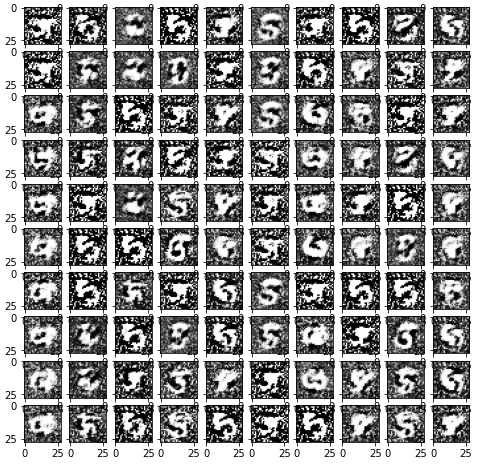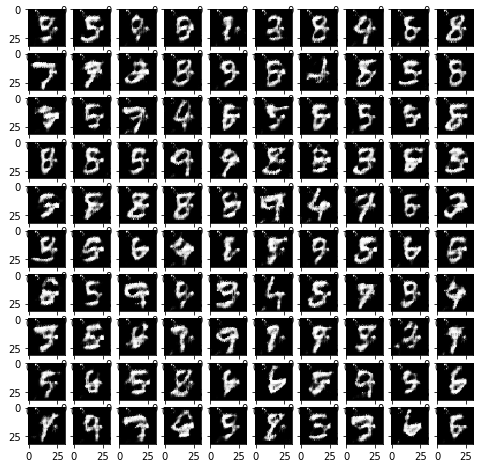CGAN 和 DCGAN
import torch
import torch.nn as nn
import torch.optim as optim
from torchvision import datasets, transforms
import numpy as np
import matplotlib.pyplot as plt
# 基本参数
z_dim = 100
batch_size = 128
learning_rate = 0.0002
total_epochs = 30
# 使用GPU训练,可以在菜单 "代码执行工具" -> "更改运行时类型" 里进行设置
device = torch.device("cuda:0" if torch.cuda.is_available() else "cpu")
# 加载MNIST数据集
dataloader = torch.utils.data.DataLoader(
datasets.MNIST('./data', train=True, download=True,
transform=transforms.Compose([transforms.ToTensor(),transforms.Normalize((0.1307,), (0.3081,))])
), batch_size, shuffle=False, drop_last=True)
CGAN
-
下面分别是判别器和生成器的网络结构可以看出网络结构非常简单,具体如下:
- 生成器:(784 + 10) ==> 512 ==> 256 ==> 1
- 判别器:(100 + 10) ==> 128 ==> 256 ==> 512 ==> 784
可以看出,去掉生成器和判别器那 10 维的标签信息,和普通的GAN是完全一样的。下面是网络的具体实现代码:
class Discriminator(nn.Module): '''全连接判别器,用于1x28x28的MNIST数据,输出是数据和类别''' def __init__(self): super(Discriminator, self).__init__() self.model = nn.Sequential( nn.Linear(28*28+10, 512), nn.LeakyReLU(0.2, inplace=True), nn.Linear(512, 256), nn.LeakyReLU(0.2, inplace=True), nn.Linear(256, 1), nn.Sigmoid() ) def forward(self, x, c): x = x.view(x.size(0), -1) validity = self.model(torch.cat([x, c], -1)) return validity class Generator(nn.Module): '''全连接生成器,用于1x28x28的MNIST数据,输入是噪声和类别''' def __init__(self, z_dim): super(Generator, self).__init__() self.model = nn.Sequential( nn.Linear(z_dim+10, 128), nn.LeakyReLU(0.2, inplace=True), nn.Linear(128, 256), nn.BatchNorm1d(256, 0.8), nn.LeakyReLU(0.2, inplace=True), nn.Linear(256, 512), nn.BatchNorm1d(512, 0.8), nn.LeakyReLU(0.2, inplace=True), nn.Linear(in_features=512, out_features=28*28), nn.Tanh() ) def forward(self, z, c): x = self.model(torch.cat([z, c], dim=1)) x = x.view(-1, 1, 28, 28) return x -
定义相关模型
# 初始化构建判别器和生成器 discriminator = Discriminator().to(device) generator = Generator(z_dim=z_dim).to(device) # 初始化二值交叉熵损失 bce = torch.nn.BCELoss().to(device) ones = torch.ones(batch_size).to(device) zeros = torch.zeros(batch_size).to(device) # 初始化优化器,使用Adam优化器 g_optimizer = optim.Adam(generator.parameters(), lr=learning_rate) d_optimizer = optim.Adam(discriminator.parameters(), lr=learning_rate) -
开始训练
# 开始训练,一共训练total_epochs for epoch in range(total_epochs): # torch.nn.Module.train() 指的是模型启用 BatchNormalization 和 Dropout # torch.nn.Module.eval() 指的是模型不启用 BatchNormalization 和 Dropout # 因此,train()一般在训练时用到, eval() 一般在测试时用到 generator = generator.train() # 训练一个epoch for i, data in enumerate(dataloader): # 加载真实数据 real_images, real_labels = data real_images = real_images.to(device) # 把对应的标签转化成 one-hot 类型 tmp = torch.FloatTensor(real_labels.size(0), 10).zero_() real_labels = tmp.scatter_(dim=1, index=torch.LongTensor(real_labels.view(-1, 1)), value=1) real_labels = real_labels.to(device) # 生成数据 # 用正态分布中采样batch_size个随机噪声 z = torch.randn([batch_size, z_dim]).to(device) # 生成 batch_size 个 ont-hot 标签 c = torch.FloatTensor(batch_size, 10).zero_() c = c.scatter_(dim=1, index=torch.LongTensor(np.random.choice(10, batch_size).reshape([batch_size, 1])), value=1) c = c.to(device) # 生成数据 fake_images = generator(z,c) # 计算判别器损失,并优化判别器 real_loss = bce(discriminator(real_images, real_labels), ones) fake_loss = bce(discriminator(fake_images.detach(), c), zeros) d_loss = real_loss + fake_loss d_optimizer.zero_grad() d_loss.backward() d_optimizer.step() # 计算生成器损失,并优化生成器 g_loss = bce(discriminator(fake_images, c), ones) g_optimizer.zero_grad() g_loss.backward() g_optimizer.step() # 输出损失 print("[Epoch %d/%d] [D loss: %f] [G loss: %f]" % (epoch, total_epochs, d_loss.item(), g_loss.item())) -
用随机噪声生成一组图像,看看CGAN的效果:
#用于生成效果图 # 生成100个随机噪声向量 fixed_z = torch.randn([100, z_dim]).to(device) # 生成100个one_hot向量,每类10个 fixed_c = torch.FloatTensor(100, 10).zero_() fixed_c = fixed_c.scatter_(dim=1, index=torch.LongTensor(np.array(np.arange(0, 10).tolist()*10).reshape([100, 1])), value=1) fixed_c = fixed_c.to(device) generator = generator.eval() fixed_fake_images = generator(fixed_z, fixed_c) plt.figure(figsize=(8, 8)) for j in range(10): for i in range(10): img = fixed_fake_images[j*10+i, 0, :, :].detach().cpu().numpy() img = img.reshape([28, 28]) plt.subplot(10, 10, j*10+i+1) plt.imshow(img, 'gray')
DCGAN
-
下面分别是判别器和生成器的网络结构,和之前类似,只是使用了卷积结构。
class D_dcgan(nn.Module): '''滑动卷积判别器''' def __init__(self): super(D_dcgan, self).__init__() self.conv = nn.Sequential( # 第一个滑动卷积层,不使用BN,LRelu激活函数 nn.Conv2d(in_channels=1, out_channels=16, kernel_size=3, stride=2, padding=1), nn.LeakyReLU(0.2, inplace=True), # 第二个滑动卷积层,包含BN,LRelu激活函数 nn.Conv2d(in_channels=16, out_channels=32, kernel_size=3, stride=2, padding=1), nn.BatchNorm2d(32), nn.LeakyReLU(0.2, inplace=True), # 第三个滑动卷积层,包含BN,LRelu激活函数 nn.Conv2d(in_channels=32, out_channels=64, kernel_size=3, stride=2, padding=1), nn.BatchNorm2d(64), nn.LeakyReLU(0.2, inplace=True), # 第四个滑动卷积层,包含BN,LRelu激活函数 nn.Conv2d(in_channels=64, out_channels=128, kernel_size=4, stride=1), nn.BatchNorm2d(128), nn.LeakyReLU(0.2, inplace=True) ) # 全连接层+Sigmoid激活函数 self.linear = nn.Sequential(nn.Linear(in_features=128, out_features=1), nn.Sigmoid()) def forward(self, x): x = self.conv(x) x = x.view(x.size(0), -1) validity = self.linear(x) return validity class G_dcgan(nn.Module): '''反滑动卷积生成器''' def __init__(self, z_dim): super(G_dcgan, self).__init__() self.z_dim = z_dim # 第一层:把输入线性变换成256x4x4的矩阵,并在这个基础上做反卷机操作 self.linear = nn.Linear(self.z_dim, 4*4*256) self.model = nn.Sequential( # 第二层:bn+relu nn.ConvTranspose2d(in_channels=256, out_channels=128, kernel_size=3, stride=2, padding=0), nn.BatchNorm2d(128), nn.ReLU(inplace=True), # 第三层:bn+relu nn.ConvTranspose2d(in_channels=128, out_channels=64, kernel_size=3, stride=2, padding=1), nn.BatchNorm2d(64), nn.ReLU(inplace=True), # 第四层:不使用BN,使用tanh激活函数 nn.ConvTranspose2d(in_channels=64, out_channels=1, kernel_size=4, stride=2, padding=2), nn.Tanh() ) def forward(self, z): # 把随机噪声经过线性变换,resize成256x4x4的大小 x = self.linear(z) x = x.view([x.size(0), 256, 4, 4]) # 生成图片 x = self.model(x) return x -
定义相关模型
# 构建判别器和生成器 d_dcgan = D_dcgan().to(device) g_dcgan = G_dcgan(z_dim=z_dim).to(device) def weights_init_normal(m): classname = m.__class__.__name__ if classname.find('Conv') != -1: torch.nn.init.normal_(m.weight.data, 0.0, 0.02) elif classname.find('BatchNorm2d') != -1: torch.nn.init.normal_(m.weight.data, 1.0, 0.02) torch.nn.init.constant_(m.bias.data, 0.0) # 使用均值为0,方差为0.02的正态分布初始化神经网络 d_dcgan.apply(weights_init_normal) g_dcgan.apply(weights_init_normal) # 初始化优化器,使用Adam优化器 g_dcgan_optim = optim.Adam(g_dcgan.parameters(), lr=learning_rate) d_dcgan_optim = optim.Adam(d_dcgan.parameters(), lr=learning_rate) # 加载MNIST数据集,和之前不同的是,DCGAN输入的图像被 resize 成 32*32 像素 dcgan_dataloader = torch.utils.data.DataLoader( datasets.MNIST('./data', train=True, download=True, transform=transforms.Compose([transforms.Resize(32), transforms.ToTensor(),transforms.Normalize((0.5,), (0.5,))]) ), batch_size, shuffle=True, drop_last=True) -
开始训练
# 开始训练,一共训练 total_epochs for e in range(total_epochs): # 给generator启用 BatchNormalization g_dcgan = g_dcgan.train() # 训练一个epoch for i, data in enumerate(dcgan_dataloader): # 加载真实数据,不加载标签 real_images, _ = data real_images = real_images.to(device) # 用正态分布中采样batch_size个噪声,然后生成对应的图片 z = torch.randn([batch_size, z_dim]).to(device) fake_images = g_dcgan(z) # 计算判别器损失,并优化判别器 real_loss = bce(d_dcgan(real_images), ones) fake_loss = bce(d_dcgan(fake_images.detach()), zeros) d_loss = real_loss + fake_loss d_dcgan_optim.zero_grad() d_loss.backward() d_dcgan_optim.step() # 计算生成器损失,并优化生成器 g_loss = bce(d_dcgan(fake_images), ones) g_dcgan_optim.zero_grad() g_loss.backward() g_dcgan_optim.step() # 输出损失 print ("[Epoch %d/%d] [D loss: %f] [G loss: %f]" % (e, total_epochs, d_loss.item(), g_loss.item())) -
用一组随机噪声输出图像,看看DCGAN的效果:
#用于生成效果图 # 生成100个随机噪声向量 fixed_z = torch.randn([100, z_dim]).to(device) g_dcgan = g_dcgan.eval() fixed_fake_images = g_dcgan(fixed_z) plt.figure(figsize=(8, 8)) for j in range(10): for i in range(10): img = fixed_fake_images[j*10+i, 0, :, :].detach().cpu().numpy() img = img.reshape([32, 32]) plt.subplot(10, 10, j*10+i+1) plt.imshow(img, 'gray')
